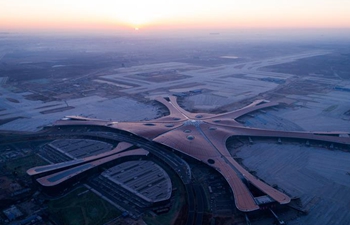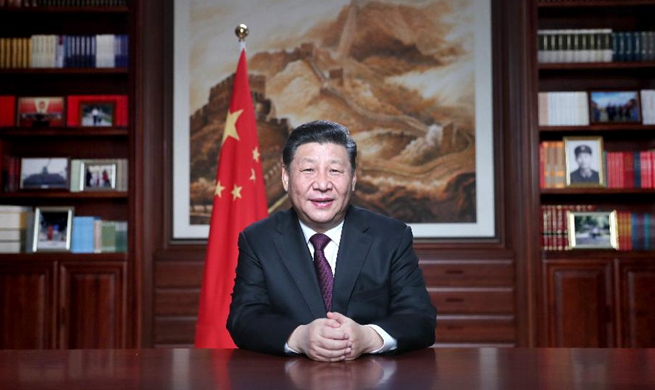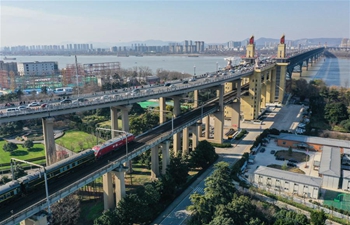KATHMANDU, Dec. 31 (Xinhua) -- The economic and trade relations between Nepal and China have seen continued growth in 2018 as China remained as the largest source of foreign direct investment (FDI), second largest source of the tourists and trading partner.
While the FDI, tourism and trade have maintained upward momentum, Nepali experts said two agreements reached between the two sides in 2018 could have transformative effect on economic relations between the two neighbors in the long run.
COOPERATION UNDER BELT AND ROAD INITIATIVE
The two countries agreed to implement the Memorandum of Understanding (MoU) on the Belt and Road Initiative to enhance connectivity in key areas including ports, roads, railways, aviation and communications within the prime framework of Trans-Himalayan Multi-Dimensional Connectivity Network during Nepali Prime Minister K.P. Sharma Oli's visit to China in June 2018. The two countries had signed the MoU on the Belt and Road Initiative (BRI) in May 2017.
Another agreement reached between the two sides is the protocol of the Nepal-China Transit Transport Agreement (TTA) in September. The two countries concluded the protocol after the TTA was signed in March 2016, enabling Nepal a vital access to China's sea and land ports for trading with a third country. Land-locked Nepal had been fully dependent on India which surrounds Nepal for outside access.
Senior economist Govinda Nepal told Xinhua on Monday that the MoU on Belt and Road Initiative has opened the door for large-scale Chinese investment in major infrastructure projects in Nepal.
Due to limited resources within the country, Nepal has to rely on foreign countries to meet its resource gap in vital infrastructure projects.
According to the economist who also worked as a senior economic adviser at the Nepal's Finance Ministry in 2016, the two countries have been talking to implement the large infrastructure projects under the Belt and Road Initiative in 2018 although concrete results are still awaited.
"Nepal has not maintained the project bank of the projects which can be developed instantly and it is taking time to implement BRI. But, there has been advanced talks and negotiations on a number of large projects which could be developed under the BRI," he said.
Proposed by China in 2013, the Silk Road Economic Belt and the 21st Century Maritime Silk Road Initiative aim to build a trade and infrastructure network connecting Asia with Europe and Africa through the ancient trade routes of Silk Road.
The Himalayan country is preparing a list of the projects which could be developed under the Belt and Road Initiative. Two of the projects proposed to be developed under the initiative are Nepal-China Cross Border Railway and Nepal-China Cross Border Transmission Line.
In 2018, the Chinese side conducted pre-feasibility study report of a cross-border railway from Chinese border town of Kerung (Geelong) to Nepal's capital Kathmandu and the report was handed over to Nepali authorities during the recent meeting in Kathmandu in December.
According to Nepali officials, two sides have agreed to pave the way for conducting the Detailed Project Report of proposed projects for the next meeting. Nepal also requested the Chinese side to conduct further studies on other two railways connecting Kathmandu and Pokhara, a western tourism city and Kathmandu and Lumbini, a southwestern town of Nepal.
When it comes to cross-border transmission lines, the State Grid Corp., one of China's two major power grid operators, and Nepal Electricity Authority (NEA) signed in June a cooperation agreement on the China-Nepal electricity networking feasibility study.
In addition, an energy minister-level meeting to implement the MoU on Energy Cooperation was held later in September in Kathmandu. During the meeting, the two sides discussed energy collaboration and the possibility of developing cross-border interconnection, among others.
The establishment of enhanced connectivity between the two countries under the framework of Trans-Himalayan Multi-Dimensional Connectivity is also expected to help implement the Transit Transport Agreement reached between the two sides.
Economist Bhoj Raj Poudel wrote in The Kathmandu Post, an English daily in Nepal, on Monday about the importance of the TTA. "Though symbolic as of now, this agreement was particularly instrumental in that it has given a sense of trade diversification by reducing our traditional dependence on India. Over time, the signing of the Trade and Transit agreement is bound to pave the path for broader engagement with China."
CHINA LEADS IN FDI
China has topped FDI commitments in Nepal for the past three years in a row. In the last fiscal year 2017-18 that concluded in mid-July, Nepal received FDI commitments of 399 million U.S. dollars from China, or 84 percent of the total FDI pledges in the country.
Although FDI pledge from China is second after India during the first five months of the current fiscal year, it is still notable investment pledge, according to the Department of Industry (DoI), which registers industries. According to the DoI, Nepal received FDI commitment of 16 million dollars during the first five months of this fiscal.
Two Chinese cement companies, Hongshi and Huaxin, have also entered Nepal, making the top two largest foreign investments in the cement sector. A Nepal-China joint venture company, Hongshi Shivam, has started producing cement in 2018 while Huaxin which signed Project Investment Agreement with Investment Board Nepal in June, is also working on establishing a factory.
Suraj Vaidya, a Nepali joint venture partner of Huaxin, told Xinhua on Monday that large scale investment in cement sector from China suggested that Nepal has been attracting large Chinese investment.
"Initially, Chinese investment came into small hotels and restaurants. Lately, we are seeing growing investment in larger industries related to power, manufacturing and hotels. We have to make further efforts to attract large investment from China," said Vaidya, who is also former president of Federation of Nepalese Chambers of Commerce and Industry (FNCCI), the apex private sector body of Nepal.
The Chinese firms have also started attracting financing from Nepali banks. For example, a consortium of five commercial banks approved 143 million dollars worth of credit to Hongshi Shivam Cement Private Limited in one of the largest investments to date in September.
CHINA MAJOR SOURCE MARKET FOR TOURISM
As of first 11 months of 2018, a total of 134,362 Chinese tourists visited Nepal, the second largest number after India as the Himalayan country saw arrivals of 1 million tourists in a year for the first time in history.
The number of Chinese visitors jumped 43.46 percent compared to the same period in 2017. In 2017, Nepal had welcomed 104,664 Chinese tourists.
Nepal will heavily rely on Chinese tourists as Nepal targets 2 million travelers in 2020 when it is organizing Visit Nepal Year-2020.
According to Vaidya, who is also national program coordinator for the Visit Nepal Year, Nepal can make a huge stride in tourism sector if it can attract 1 percent of its tourists from China.
"China and India are our major targets for promotional activities to attract more tourists targeting the Visit Nepal Year," he said. "We will organize road shows and many other events including media partnership in China."
Meanwhile, the Neal-China trade has been growing over the years with bilateral trade reaching totaling 1.44 billion dollars in the last fiscal year 2017-18 that concluded in mid-July, according to Nepal's central bank.
During the first four months of the current fiscal, bilateral trade has already reached 640 million dollars, the Nepal Rastra Bank said. But, Nepal recorded a trade deficit of 626 million dollars as of the first four months of this fiscal year.
To promote trade balance, China has offered duty-free access to more than 8,000 Nepali goods but Nepal has failed to cash in on this opportunity due to lack of products for exports. Nepal has been basically exporting handicraft products including metal and woolen crafts, pashmina and silver jewelry among others.
Nepali handicrafts manufacturers said although handicraft products are dominating exports to China, they are yet to make any sizable presence in China. "Considering the huge trade deficit and Nepali handicrafts products being the major export items to China, Nepal should seek duty free access for handicraft products too," said Subindra Bajracharya, assistant director at Federation of Handicraft Associations of Nepal, a group of handicraft manufacturers.
With Nepal having limited products for exports, experts suggest that Nepal could focus on service trade to reduce the gap in trade. "We can focus on tourism to reduce the impact of trade deficit with China," said economist Nepal.













